|
September 1957 Popular Electronics
 Table of Contents Table of Contents
Wax nostalgic about and learn from the history of early electronics. See articles
from
Popular Electronics,
published October 1954 - April 1985. All copyrights are hereby acknowledged.
|
"Mobile telephone equipment
installed in the trunk of the car takes up relatively little space, is out of the
way." That sentence seems really strange in today's world of pocket-size mobile
phones, but it was a big (literally) deal in 1957 when this article appeared in
Popular Electronics magazine. If you are getting old (but not
old yet) like me, you'll remember the prime time TV show called
Mannix,
where crafty private eye Joe Mannix had a "futuristic" Motorola car phone in his
convertible. Today, the only kind of radio you are likely to find installed in a
car trunk is a high-power Ham rig. Two-way messaging was a big deal before the advent
of cellphones. Service trucks were dispatched by operators at the home base. As
an electrician back in the 1970s, most of the trucks I operated from had a two-way
radio for directing workers to job sites. I did a lot of troubleshooting and old
work (adding circuits and equipment to existing establishments, as opposed to new
construction work), so I typically went to numerous job locations each day.
Radio Keeps You in Touch
By Leo G. Sands and Mike Bienstock
 Paging and telephone systems use radio waves
to keep pace with today's business world Paging and telephone systems use radio waves
to keep pace with today's business world
You're a doctor. You're out on a call this evening, and it's a half-hour drive
to your patient. When you get there and call in, your nurse tells you one of your
patients has had a serious accident. He's in the hospital now, and they're operating.
You're a doctor. You're out on a call this evening, and it's a half-hour drive
to your patient. Suddenly the phone under the dash rings once. You pull over, pick
up the handset, press the button, and you are in instant contact with your office.
Your nurse tells you one of your patients has had a serious accident. You speed
to the hospital where you are in time to supervise the operation.
Did that sound nice, but a bit futuristic? You're partly right. It is nice, but
communication with a moving car is here today, a bustling youngster growing lustily
and with practically an unlimited future. The prospects are tremendous, not only
for the doctor who receives emergency calls, but for anyone whose business requires
him to keep in constant touch with home base ... salesmen, who may get tips on customers
... executives whose advice may be needed to make a critical decision ... newspapermen,
who may be routed to cover a top story while it's happening ... radio and television
servicemen who may be sent on an emergency. The list is nearly endless.
There are a wide variety of services available. Let's examine them in order of
cost and complexity.
One-Way Radio Paging. Not quite the same as the Dick Tracy wrist
radios, these receivers are pocket-size jobs which weigh a few ounces. They can
be rented or bought at a cost of about $50. The subscriber to this private service
takes the tiny radio out of his pocket, holds it to his ear, presses a button and
listens. The names or call numbers for those with messages waiting are transmitted
from a base station. Generally the information is taped and rebroadcast until the
subscriber calls in, then the signal is erased.
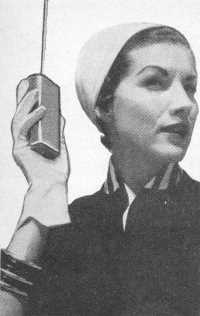
The little lady is shown demonstrating one-way radio paging.
Subscriber presses button and hears the taped message.
To extend this service over a greater range, a mobile receiver with a built-in speaker
can be mounted under the dash. Since a superheterodyne circuit is used, the range
is stepped up. The car battery furnishes the power to operate the set.
Telephone companies provide a similar auto signaling service. The signal is a
buzzer and light. Installation for such service is half of the regular auto radio-to-telephone
service - $25 for most areas, plus $12.50 for rental and maintenance, plus a minimum
calling charge of $5 which would pay for 30 to 40 calls.
Message Service. This is handled by private communications firms.
The installation includes equipment similar to that used in regular mobile radiotelephone,
which will be described under that category. The service differs in this way: instead
of direct voice contact between both parties, the message is shorts topped by a
third person, the company operator.
Suppose the doctor's nurse wants to call him. She rings up the private operator
and gives her the message she wants delivered. Then the operator calls the doctor
on the road. He gets the signal, picks up his mike or handset, and answers her.
She gives him the nurse's message. Direct communication, of course, would be in
violation of the common carrier tariff filed by the telephone company.
Typical charges in the New York area are as follows: a monthly fee of $36.30
allows 100 air-minute messages, after which you are charged 10 cents per call. Incoming
messages are billed at a straight 10 cents each. The fee is broken down to $17.50
monthly for service, $10.50 for rental and $5 for maintenance. There is a 10% Federal
tax. Installation charge is $25 per unit, and removal charge is $10 payable in advance.

Mobile telephone transmitter and receiver control panels at Pacific
Telephone & Telegraph Co.
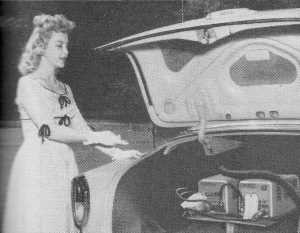
Mobile telephone equipment installed in the trunk of the car
takes up relatively little space, is out of the way.

Message service control center is operated by two persons, one
taking telephone messages, the other on radio. (Anti-science people like a certain
country's president would lament the replacement of these types of jobs with automated
computerized equipment, similar to
ATMs stealing tellers' jobs.)

Car is equipped with a two-way Bendix mobile unit provided by
message service common carrier.

A typical mobile telephone is installed in the car below. Note
handset holder and control unit under dash.
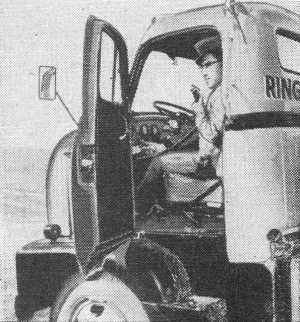
RCA installation of a two-way mobile radio system at a large
trucking firm.
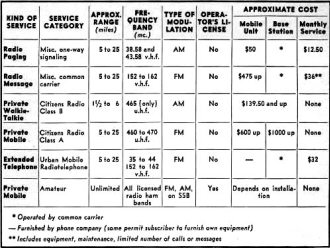
Citizens Radio Service.
There are three types in this category: Class A, B and C stations. We are concerned
with only the first two, since Class C is strictly for remote control transmission.
Class B stations may only be operated on 465 mc., with a maximum input power
of 10 watts. Class A may be operated on any frequency in the 460 to 470 mc. band,
with power limited to 10 watts between 462 and 468 mc. and 50 watts on the other
frequencies.
The further distinction between the two is that equipment cost for Class A transmission
pretty well limits its use to commercial firms interested in getting distance, which
is usually eight to ten miles, depending on terrain and conditions. Class B, therefore,
is generally used by private citizens who get a range of one-and-a-half to six miles,
depending on conditions. Vocaline makes transceivers for this band which sell for
$139.50 a pair. They require no installation.
For a Class A installation, initial cost may run to about $700 for the car equipment
and $1200 for the base station, which can be at home or in the office. It may cost
more if a tall antenna support is needed at the base and if a heavy-duty generator
is necessary in the car. The equipment will give a range of eight to ten miles in
most areas even without elaborate antenna systems at the base. The higher the base
antenna, of course, the greater the range. Reflection characteristics of u.h.f.
make it possible to enjoy good communication in shielded areas such as streets lined
with tal1 buildings.
The car antenna is a small vertical whip about 6" long, mounted on the car roof.
The radio equipment is usually mounted in the trunk and is housed in a single metal
case which includes the transmitter, receiver and power supply. A loudspeaker, hand
microphone and a small control unit are mounted on or near the dash.
The base station transmitter, receiver and power supply are generally enclosed
in a desk-mounted cabinet. It is only necessary to plug it into the closest outlet
and connect to an antenna system.
With such a Citizens Radio setup, operation is very similar to police or taxi
operations. Since it operates on u.h.f, there is little or no noise. No special
skill is needed to work it. It is already pre-tuned to your frequency. In the car
there are only three controls: an "on-off" switch, a volume control, and a squelch
control which eliminates background noise.
When you hear your office call, you pick up the microphone, press the button
on it and talk. When you are through, you release the button to hear the incoming
message. The base station operation is similar except that a desk-type microphone
is generally used. Telephone handsets may be used in place of microphones.
Specific frequencies are not assigned in Citizens Radio. You can order your equipment
for any frequency in the band. If you find that someone else's system interferes
with yours, you may have your frequency changed.
No operator's license is required. To get your station license, fill out and
mail FCC Form 555 to the nearest FCC field office or to the FCC in Washington. Your
equipment must meet FCC approval.
Mobile Telephone Service. Just as the name implies, this means
a telephone in your car. Similar to ship-to-shore radio-telephone, the system is
operated by the local telephone company and makes a phone booth of your car. Under
the dash there is a control unit with signals to light when power is on, a bell
and a hand phone which fits into a hanger on the unit. When you are called, the
bell rings, a "call" light goes on and you pick up the handset, press the button
in it and talk - just as simply as if you picked up your home phone. The latest
addition is a "dial-direct" system by Du Mont, which allows direct dialing in the
local phone network.
In the trunk of the car, there is a v.h.f. transmitter, receiver, power supply
and dialing decoder. A short antenna is mounted on the car roof, and sometimes an
oversize generator is furnished to take the added load from the battery.
By picking up the handset and pressing the push-to-talk button, the driver can
signal the phone exchange. When the operator answers, he gives the number of the
phone he wants to reach, identifies his own unit by number, and the call is placed.
Calls to mobile units can be placed from any telephone or from similar mobile installations.
To sum up, this system is essentially the same as an ordinary phone installation,
with radio being used in place of phone wires. Generally the phone company has one
transmitter in the headquarters building, with several receiving stations at strategic
locations. Transmitting and receiving stations are connected by telephone lines
to the central office.
The range of the system is generally confined to the 15 to 25 mile radius of
the transmitter. The service is on a "party line" basis, with several subscribers
using the same channel. Charges for such service - in a large area of the country
(including such cities as New York, Cleveland, Chicago, Philadelphia, Los Angeles
and Dallas) are $50 for initial equipment installation and $32 monthly. The monthly
cost includes maintenance as well as a minimum charge which pays for 15 to 20 calls.
Additional calls cost 30 cents or more, depending on distance and length of conversation.
Other Services. There are, of course, other services. These,
however, will only be mentioned, since they ordinarily are not available to the
private individual. Private Two-Way Radio, Licensed, includes police, taxis, railroads,
bus lines, utilities and pipeline companies who have for years used their own mobile
sets. Amateur Radio Mobile Service is ordinary amateur radio moved into the air.
An operator's license is needed, which limits the latter service to relatively few
people. Note that while Citizens Radio is open to any citizen for private or commercial
use, Amateur Radio Mobile Service is strictly limited to personal use with no profit
motive.
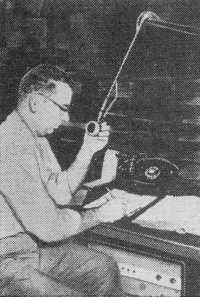
Dispatcher is shown in communication with one of the local pickup
and delivery trucks.
Posted January 18, 2021
(updated from original post on 4/8/2012)
|








 Paging and telephone systems use radio waves
to keep pace with today's business world
Paging and telephone systems use radio waves
to keep pace with today's business world 








